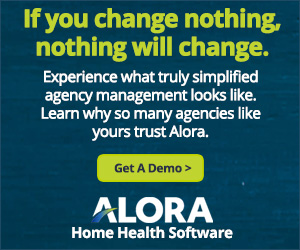
06 Aug Six Steps to a Successful EMR Transition in Home Health
Six simple but effective action steps for home health execs and owners.
Your agency needs technology that is compliant, easy-to-use, and scalable. If you’re thinking about switching your EMR, proper planning is key. But switching to a new electronic medical record (EMR) system is a unique challenge for home health agencies. Often, they have limited resources to devote to technology and training.
Whether you are a home health owner or executive considering transitioning to a new EMR or making technology upgrades, you need to know how to get the job done with the fewest headaches. Here are six simple but effective action steps for a successful EMR transition
The Goals for a Successful EMR Transition
Having the right system can improve the quality and safety of patient care.
So when building out your strategy, the primary goals are to maintain care quality and patient safety throughout the process. Home health agencies want to prevent or at least minimize service interruptions. Since patients are typically seen during normal business hours, the ideal time for a system update is overnight or during the weekend.
Another important goal for an EMR transition is to avoid frustration for staff members. Home health professionals, nurses especially, are in high demand. You don’t want to lose them over annoyance with your new system.
Now that you know the “why” let’s dive into the “how” of home health care EHR transitions.
How to Prepare Your Home Health Agency
Moving to new hardware or software can be scary, but it will be worth it in the long run. The best thing you can do is to prepare in advance. Here are six practice steps to prepare your home health agency for a successful EMR transition.
Plan for Expenses
With continued home health reimbursement cuts by CMS and some insurers, you want to be prepared for the expense associated with EHR implementation.
Planning for expenses also includes time commitments and staff resources. This is critical. Here are a few questions to ask yourself.
- Should you restrict time off requests during the transition period?
- Who will need input from along the way, and when or how will you meet? Develop a strategic plan or roadmap.
- What additional expenses will you incur for staff training and meetings?
Standardize Operations
For a successful EMR transition or upgrade, you must have established workflows. Also, your vendor may need to see your processes to customize user training and train your team for optimal performance within your agency. In the early planning stages, analyze your current workflows and write out any processes that may need clarification. Make sure that your operations are HIPAA compliant.
Another key point to remember, you should postpone any other significant changes within your agency for a few months. You don’t want to overwhelm your teams during a transition period. Avoid rolling out any new procedures or initiatives. Stick to the current processes so your team can focus on the EMR transition. It will help alleviate stress for your teams– and yourself.
Tailor Your Training
Staff training should be tailored to your agency. Experts debate about the best way to train your staff on new EHR systems. Here are a few approaches to consider. Your training program may be a combination of these methods.
- Classroom style: Employees meet at a site, and a trainer leads the training using slides and activities. Consider space availability, catering costs, and employee availability.
- Interactive training: Staff complete practice lessons on their own in a “sandbox” environment and learn independently. It is not for everyone. Some employees need regular feedback. But this method saves time and money.
- Online or eLearning: Online courses, webinars, and videos present the material differently to accommodate different learning styles. The downside is it can be time-intensive and costly to set up.
When you have developed your training plan, create a schedule and secure the right teachers to train your team.
And don’t forget, training for your new system will likely go past the go-live date. You want to support your teams as they adjust. Invest time and resources into trainers who will be available to help staff as needed.
Identify and Remove Roadblocks
Spend time analyzing how your new system will integrate with your current processes. Consider how it will work for your teams. Look for areas where you may encounter roadblocks to change so you can eliminate them early.
Employee resistance is a difficult roadblock you may encounter. To overcome it, ensure you have “buy-in” from key stakeholders like managers and supervisors. Also, ensure you are over-communicating with them and addressing their concerns.
Choose your Champions
Appoint implementation leaders, or champions, to support and encourage your staff. They will boost employee morale throughout the implementation process.
One study found that successful EHR transitions depend on teams going beyond the technical aspects to consider social factors during implementation.
Your designated champions will be a resource to their peers and also communicate feedback to management. Their role will reassure your employees that the implementation is a collective, group process rather than one person making decisions on their own for the entire group. They’ll send the message, “Hey, we’re all in this together!”
Use Your Vendor as a Resource
Your EHR vendor will likely offer tools or services to make your implementation more seamless. You want to reap the full value of this significant investment you are making. Talk to your vendor about your training and implementation plan. They will likely provide a roadmap. And you can adjust it to meet the needs of your agency.
Summary
These practical steps will help you prepare and navigate your next EMR update or upgrade. Now that you have them, you’re more likely to make a smooth and successful transition. Look ahead, knowing it will all be worth it!
Author’s Note: This resource’s views, information, and guidance are intended for information only. We are not rendering legal, financial, accounting, medical, or other professional advice. Alora disclaims any liability to any third party related to this content. We cannot make any guarantee related to the content.
Sources & Additional Reading
“Factors and Forces Affecting EHR Adoption”. academic.oup.com. Accessed July 6, 2022.
“Improving Safety with Information Technology”. pubmed.ncbi.nlm.nih.gov. Accessed July 6, 2022.
“The Role of Cognitive and Learning Theories”. journals.sagepub.com. Accessed July 6, 2022.

Alora provides agencies with the complete solution for home health agency workflow. Administrators and clinicians have a partner in ALORA from a regulatory, clinical and operation standpoint. Adoption of the right home health EMR can be the difference between an agency’s success and failure.





No Comments